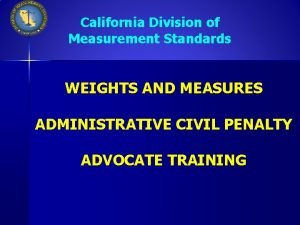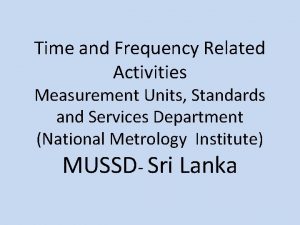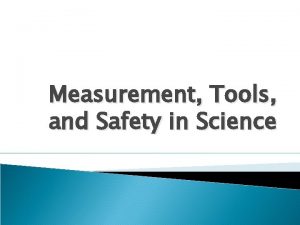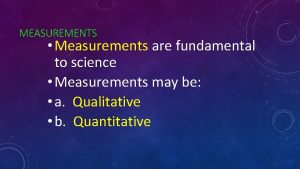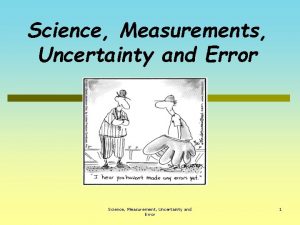Measurements in Science Measurement Standards All measurements are









- Slides: 9

Measurements in Science

Measurement Standards � All measurements are comparisons to some standard � Standard measures are kept in a central location, such as the standard kilogram at the National Research Council (NRC) Laboratories in Ottawa Canada’s Kilogram : K 74

� Measurements describe quantities such as length, mass, or temperature. � A quantity is a property that can be measured and described by a number and a unit that names the standard used. � Science deals with relationships among quantities, and the rules of mathematics must be adapted to handle quantities. � Only like quantities can be added or subtracted. � Units are important because they name the quantity measured.

Metric (SI) Units � Scientists use Le Systeme International d’unites, or SI. � SI is a modification of the older metric system which was used in France. � SI has the same numerical base as the decimal number system: every unit in the system is ten times the size of the next smaller unit, just as every place in a multi-digit number has ten times the value of any place to its right. � SI units for various quantities are defined in terms of units for simpler quantities whenever possible. Le Grand K

SI Base Units

� All SI units are derived from the base unit by using prefixes which stand for some multiple of ten � We will focus on: kilo, deci, centi, milli, micro (these should be memorized)

Using Unitary Rates � Centi- is the prefix meaning “one hundredth” � One centimetre is one-hundredth of a metre. � 1 cm = 0. 01 m or 100 cm = 1 m

Derived Quantities �Base units are limited in describing all the quantities you observe.

�Converting derived quantities 100 cm = 1 m 1 m x 1 m = 1 m 2 100 cm x 100 cm = 10 000 cm 2 (100 cm)2 = (1 m)2 10 000 cm 2 = 1 m 2
 Mikael ferm
Mikael ferm Her favourite subject be english
Her favourite subject be english Draw three noncollinear points j k and l
Draw three noncollinear points j k and l International property measurement standards
International property measurement standards International construction measurement standards
International construction measurement standards Measurement standards laboratory of new zealand
Measurement standards laboratory of new zealand Section 2 standards of measurement answer key
Section 2 standards of measurement answer key Department of measurement standards
Department of measurement standards Mussd
Mussd Hard customer defined standards
Hard customer defined standards







